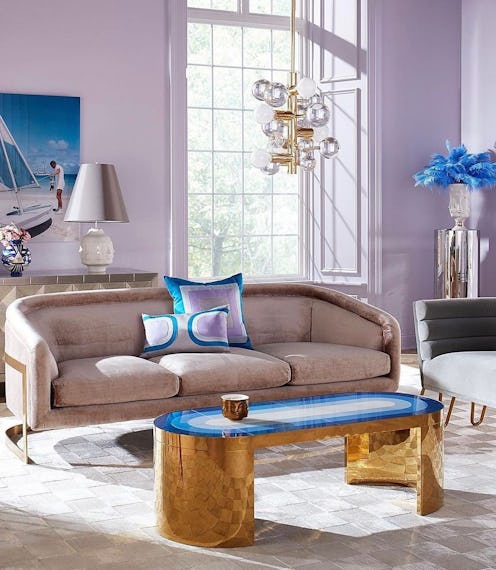(Home)
Yes, You Can Make These “Ugly” Paint Colors Work — Here’s How
Even purple has its place.

Though the world at large seems to be embracing bold colors more these days, there are some hues that still seem to be on the “hard pass” list for many when it comes to paint. Regardless of how versatile they may *actually* be, it’s hard to forget that time you saw a cringey red dining room or a pastel yellow living room that looked more like a nursery. The thing is though, some of the “ugly” paint colors with the worst reputations can be the most beautiful when used on the walls of a home. They just have to be incorporated with a thoughtful touch.
So, before you run out and splurge on that brown shade you’ve been considering or the jewel-toned purple that’s secretly calling your name, take the time to brush up on a few rules of thumb on how to apply them to your space. Yes, when it comes down to it, you should do what truly speaks to you. But if you’re just not sure how to go about using a color that’s typically “unwanted” on the walls over your space, the expert suggestions ahead can help guide you in the right direction.
We only include products that have been independently selected by TZR's editorial team. However, we may receive a portion of sales if you purchase a product through a link in this article.
Yellow
Yellow paint gets stuck with a lot of labels, from childish to just plain unsightly. That’s why when using it, it’s important to focus on which kind of yellow you choose, as well as where you put it. “Yellow is a very classical color in many respects, but of course the shade and application matter greatly,” Rebecca Johnston of R.Johnston Interiors tells TZR. “You want to make sure you account for the overall design and mood of the space to ensure you are using the proper shade and application of yellow.”
A few examples of how this can play out? For living rooms or kitchens, you may consider using a paler shade, and incorporate millwork to break things up. For a smaller area, like a powder room, it’s easier to get away with a brighter shade because it’s not as likely to overwhelm.
When it comes to color pairings, Johnston says in general, you can treat yellow as a neutral and pair it with complementary colors or white. “This will allow for the color to work harmoniously in the space.” That said, use a light hand no matter what you combine it with. “I would recommend against using yellow with too many other colors at once; the result could be overwhelming and messy.”
Red
Mary Patton of Mary Patton Design feels much like the rest of us when it comes to this shade: “When I first think of a red room, I think of a ‘90s dining room,” she tells TZR. That said, she does explain that it’s possible to use red paint in a fresh, bright way.
That starts with avoiding the trite. “Because of that dated cliché, I would tend not to use it in a dining room, but a space like a powder or guest bath would be fun.” And when you do incorporate it, “go for something bright, pushing more towards coral [or] orange than brown” and beware of cheesy color pairings. Green or royal blue with red can end up looking like Christmas or July 4th, says Patton, who prefers a monochrome look instead. “Using warm pinks and darker reds would be cool.”
Brown
Brown tends to immediately conjure the word Ew, but Patton holds that using the color in the right way can make for an effect that’s quite the opposite. “A dark, dark brown room can be very masculine and edgy,” she says. “I would paint the entire room in that space and then use cream furniture with natural wood accents.”
However, there are some shades you may want to skip. “Anything that reads ‘builder blah.’” Rather, she reiterates, stick with the dramatic. “If you are using brown it needs to be dark.” And once you have the right shade, you don’t have to be too picky about how you style it — though maybe don’t go overboard layering it with bright hues. “Dark brown is very neutral, so you could mix most colors with it. I would stick to one pop of color and keep everything else a light neutral.”
Purple
Purple is well known for making houses look “dated” or even just overwhelming. But if you love it, there are definite ways to avoid that happening, says Eleanor Trepte of Dekay and Tate. “Purple and its various shades are actually very calming and can add a lot of serenity and interest to a room, when done right,” she says. “If you're not ready to take the plunge and paint all four walls of your room purple, we recommend painting your ceiling or even just an accent wall as a way to bring in the color without overwhelming.”
If you want to tone down the color once it’s up on the walls (or ceiling) and make it look more modern, Trepte says that “complementary colors like blue and green always work well.” And if you want to make purple the star? “I would recommend using neutrals for the rest of the space, such as white, gold, or even dusty pink.”
As for picking a shade, the designer says she wouldn’t outlaw any particular ones; it’s more about how you use them. “A very deep aubergine would likely work beautifully in a dining room or as an accent wall, whereas a lilac might be sweet in a nursery or bedroom,” she says. “Knowing your space and what type of mood you want to achieve in the room will help guide you to the right shade.”
This article was originally published on